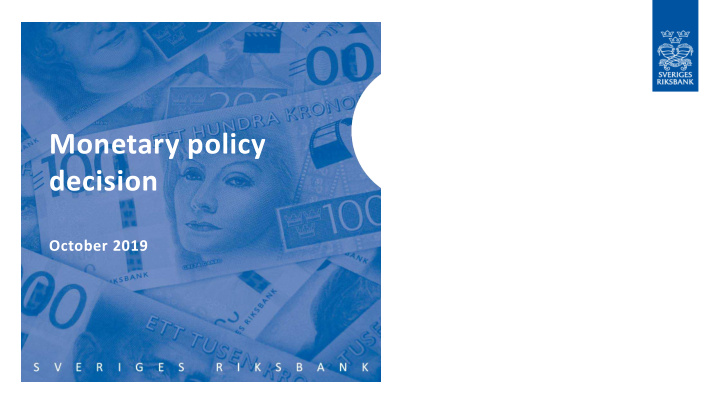



Monetary policy decision October 2019
Slowdown towards a more normal economic situation
Slowdown in international growth Continued high confidence among households Clear decline in manufacturing sector confidence Index and deviation from historical average, respectively Sources: Conference Board, European Commission, Markit, ISM and the Riksbank
… but no recession in the forecast Strong labour market Growth close to normal levels Per cent of labour force and annual percentage change. Sources: Bureau of Economic Analysis, Eurostat and the Riksbank.
Weaker confidence indicators in Sweden, too In the manufacturing sector and among households Index, seasonally-adjusted data. Average for PMI calculated since Sources: Swedbank and the National Institute of Economic Research 1995.
Actual figures give a brighter view, but GDP growth revised down Strong consumption and output Calmer growth ahead Index: 2010 =100 Annual percentage change Sources: Statistics Sweden and the Riksbank
Labour market weakening Unemployment has risen slightly Recruitment plans at historical average Average for recruitment plans from 2001. Per cent of labour force, 16-64 Sources: Swedish Public Employment Service and National Institute of years, and net total, per cent respectively Economic Research
From clear economic upswing to more normal economic situation in Sweden Negative interest rate and government bond purchases since start of 2015 • Good GDP growth • Strong labour market • Inflation back around target Faster slowdown towards more normal economic situation
Inflation prospects largely holding up Annual percentage change Sources: Statistics Sweden and the Riksbank
Low interest rates continuing to support economic activity and inflation Slowdown towards more normal economic situation Inflation prospects largely the same Likely that repo rate will be raised in December Uncertainty over economic outlook and inflation prospects Repo rate, per cent Source: The Riksbank
Swedish krona at weaker levels Source: The Riksbank. Note. Outcomes are daily rates and forecasts refer to quarterly averages. KIX refers to an aggregate of countries that are important for Sweden's international transactions.
Slowdown towards a more normal economic situation
Recommend
More recommend